Photography by Sasha Israel
“IF YOU UNDERSTAND SPICES, IT CAN REVOLUTIONIZE YOUR COOKING,” says Padma Lakshmi while sprinkling a pinch of richly auburn-hued sumac over a bowl of garbanzo beans and spinach in the kitchen of Little Owl, The Venue, a charming event space quietly nestled in the West Village. “You can add sumac, Za’atar or all sorts of things to make your food livelier and stimulate your palate so you feel like you’re eating something exciting.” With a brand new book entitled The Encyclopedia of Spices & Herbs: An Essential Guide to the Flavors of the World inspired by her childhood spent exploring the aisles of Manhattan spice Mecca Kalustyan’s, the information-rich tome explores the vast landscape of spices including their provenances, culinary uses and even medicinal applications. (Sure it’s great in pumpkin pie, but did you know allspice can be used to relieve toothaches?) The book is just one piece of Lakshmi‘s ever-growing empire that includes a spate of cookbooks, a memoir and a new line of frozen food dubbed Easy Exotic Rice sold at Whole Foods–not to mention a burgeoning social media following on Instagram, Twitter and Facebook where behind-the-scenes work outtakes mingle with envy-inducing bikini shots. Ever the paradigm of balance (the Top Chef judge and host deftly juggles a career of tasting indulgent haute cuisine while simultaneously pulling off a stunning, body-con Alaia frock) Lakshmi credits much of her physical well-being to mastering the art of spices. “Often when you are dieting, you’re eating lean protein, brown rice and vegetables,” the Emmy nominated model-turned-author continues. “You can use those same ingredients and by changing your spices, have four completely different dishes for the week and it doesn’t feel as monotonous or boring. You can still eat deliciously while remaining conscientious.” Below, Lakshmi, talks essential oils, lymphatic massage and the face cream she puts everywhere.
What inspired The Encyclopedia of Spices & Herbs?
I always wanted a reference book on spices. I have the Food Lover’s Companion and the Cambridge History of Food and I wanted a user-friendly place to look spices up. Yes, you can Google anything these days but it’s nice to have something like this in your library.
Your book is so in-depth. You must have learned so much while researching it. Is there anything you learned that really surprised you?
I learned that there are thousands of types of chilies. Chilies are so beautiful and nuanced. They’re like wine. They have notes of fruitiness, smokiness and tobacco. Understanding them is a world unto itself.
Everyone has classic crushed red pepper in their pantry. What’s another variation of chili that can take you to the next level?
Urfa chili pepper, which comes from Turkey. It’s fruitier and has a high oil content, so it’s more of a moderate and smoky heat. It’s great in salad dressings. You don’t know what you’re tasting, but it’s really good. It gives a really good vegetal, almost umami taste. Another one is Aleppo chilies from Syria. Aleppo comes from Syria, so right now with all the political turmoil, it’s probably more costly to get. Putting a pinch of urfa when you’re making baked eggs or shakshuka is so delicious. You don’t want that sharp, spiciness in the morning. I also whisk it into yogurt with za’atar and salt.
Are there a few off-the-radar spices that you think everyone should have in their pantry?
Sumac and green mango powder are great with fish. They are both souring agents. Usually the way we add tartness is in a liquid form. But sumac was being used before the discovery of citrus. The Romans for example used sumac. Even the Native Americans used sumac as cough syrup. If you want to do a carpaccio, go to a really good fish monger and they’ll usually navigate you to which fish to buy. Then use a little green mango powder and just sprinkle it with a little olive oil and yuzu and you’re done.
In addition to your spice box, what is another alternative essential to have in the kitchen?
I love Moroccan food. Preserved lemons is a staple I keep in my fridge.
Throughout your travels, is there a certain culture that has inspired or surprised you?
Mexico is a place we don’t fully understand yet. We think of Mexican food as burritos, chips and salsa. But the same ingredients that make Asian food interesting are what make Mexican food interesting. In certain parts, they have something called Recado Rojo, which is a spice blend. It’s like their version of Ras Al Hanout or garam masala. The housewives make it themselves and use it to make their stews. You can take a plain rice and put a little bit of hot sesame oil and a teaspoon of that, all of a sudden you have a really interesting rice pilaf without doing much.
What is your advice to parents who are afraid to use spices with their kids?
There are spices that you actually should feed children in small doses, like cumin. I think the reason that children don’t eat well in this country is they go from baby food and chicken nuggets to really adult food with no in-between.
In the book, the medicinal application of spices plays a big role. How does that factor into your own life?
For me, I love spices in the form of essential oils. If I want to detox, I’ll do a topical oil with ginger or black pepper, but you have to be careful with black pepper, it can burn. I use a carrier oil like jojoba oil because it’s lighter than almond, almond can be greasy and clog your pores. Jojoba has molecular structure that’s very close to human sebum so it lays on the skin lighter. You can use ginger or fennel oil if you’re bloating and gassy. Just put the essential oil in the carrier oil and massage it everywhere. It’s great if you’re trying to fit into a wedding dress or a lingerie shoot. I do that the night before the Emmy’s.
Are there other ways that you stay balanced while working and traveling?
Whenever I finish a season of Top Chef, I’m usually about fifteen pounds heavier than when I started so I go into a food detox. I won’t eat red meat, flour, fried food, any sweets, alcohol or most dairy other than yoghurt or sheep’s.
What’s one of your most clean, nourishing dishes that you love to make?
I make a very light but well-spiced coconut curry. It’s thinner than Thai curry and more brothy. Think of a Tom Kha Gai soup but picture an Indian version of that with fish or chicken. I like to use halibut or cod and I prefer unsweetened coconut milk. I stopped buying low-fat coconut milk, all they do is add water.
What is your workout of choice?
Mendez Boxing on 23rd and Madison. I’ve been boxing for 15 years. Ideally, I do it 2 to 3 times a week. It’s great cardio and less monotonous than a spin class. I lift as well.
What do you think about the misconception toward lifting weights? Women seem afraid!
You have to lift weights as a woman. It burns more calories than cardio. It also shapes you! Doing squats and deadlifts will sculpt the body. It’s vital.
To compliment your workouts, how important is self-care to you?
It’s very important, especially as you age. It rejuvenates me. I’m not going out and partying. For me, a treat is to get a massage. I like lymphatic massage with oils. I also love dry-brushing.
What’s one of your favorite self-care rituals?
I make my own bath salts. I get a big mason jar and add a carton of Epsom salts and jojoba oil. I mix 3 cups of salts with about 6-8 ounces of oil. To relax, I’ll add lavender. To detox or lose weight, I’ll use grapefruit and juniper. For my muscles, I’ll do rosemary and eucalyptus. Knowing what the medicinal properties of these ingredients are allows you to custom blend. You can even add rock sugar to buff your skin. When massaging, remember, always circle up toward the heart.
You have amazing skin. What is your regimen?
I get a facial every six weeks with Christine Chin. I’ve been going to her for years. If I want to look good the day-of, I’ll go to Tracie Martyn. I use a combination of their products and Shiseido foaming wash. My problem isn’t puffiness, it’s looking sunken in. It sounds bad but sometimes before a big photoshoot, I’ll actually have a glass of white wine right before I go to sleep, so everything puffs up a bit.
Do you have any at-home treatments?
I put honey on my face. I use the cheap honey that’s in a plastic container. Wash your face and pat it dry, then slather honey all over and tap your skin like you’re playing piano. The amount of viscosity and stickiness in the honey will pull out impurities from your skin.
Favorite skincare product?
Tracie Martyn sculpting face cream. I use it on my body. I don’t use it everywhere because it’s expensive. I just use it on the back of my thighs. It works.
You travel so much for work, which can wreak havoc on the skin. What’s your secret?
I always travel with a small bottle of tea tree oil. I’ll ask the hotel if the kitchen can bring me a bowl of boiling water. I put a towel in the water with a few drops of tea tree oil. It gets rid of everything. When I’m on the show, I get my makeup done everyday for six weeks so just it’s great for clarifying and getting that gunk off.
Do you have any other travel tips?
Drink a lot of water. I drink 500 ml of water every half an hour. I don’t drink alcohol on the plane unless I need to get to sleep. Then I’ll have one glass of red wine. I’ll usually have a vitamin C packet right before I go and then put on an eye mask. And I never wear makeup on a plane. That is the biggest thing. Makeup dries your skin and being in that recycled air can clog your pores.
What are some of your favorite cookbooks?
I have a really old one from Marcella Hazan. I like classic cookbooks. I love Plenty. I never follow the recipes in there, I just get ideas. I also like Ad Hoc by Thomas Keller. I love all the classic books from Diana Kennedy.
Take us through an average day of meals when you’re not shooting?
I wake up at 7 A.M. and have one cup of English Breakfast tea with milk and honey. Then I have breakfast at 7:30 A.M. and it’s usually two eggs poached, sometimes scrambled if I’m running late with some avocado or leftover sautéed asparagus. If I’m feeling skinny, I’ll have that with a slice of sourdough toast. If I’m not feeling skinny then I’ll have it over a scoop of cottage cheese. If I’m really pressed for time I’ll do a protein shake.
Lunch is usually leftover fish and rice or lentils and rice. If I want to lose weight then I just very quickly sauté a filet of white fish and wilt spinach with a spoonful of Indian pickle or spice. Instead of rice, I’ll do a small red potato that’s boiled. It’s all about keeping things very simple and adding a few spices. A good spice box is like a painter’s palette. If you have an array of things of hand, that piece of fish or chicken breast is no longer boring.
Padma’s Chickpea & Spinach Tapas
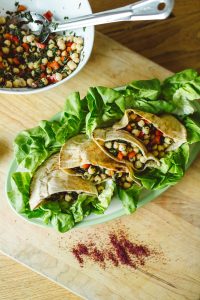 Serves 4
Serves 4
10 oz. fresh spinach leaves, rinsed –or- one 10 oz. package frozen leaf spinach
2 cups cooked chickpeas, drained and rinsed
1 red bell pepper, small dice
1 tablespoon snipped fresh chives
Juice of 1 to 2 lemons, or to taste
¼ to 1/3 cup extra virgin olive oil
1 teaspoon ground sumac
Salt and freshly ground black pepper, to taste
If using fresh spinach, cook the spinach in a saucepan with the water clinging to its leaves, stirring, until wilted. Drain, squeeze dry, and finely chop. If using frozen spinach, follow package directions, drain, squeeze and finely chop.
In a bowl, combine the spinach with the chickpeas, pepper, chives, lemon juice, oil, ground sumac, salt and pepper. Serve as is, or chilled with toasted bread, or as a filling for pita pockets. Also great in butter lettuce cups.

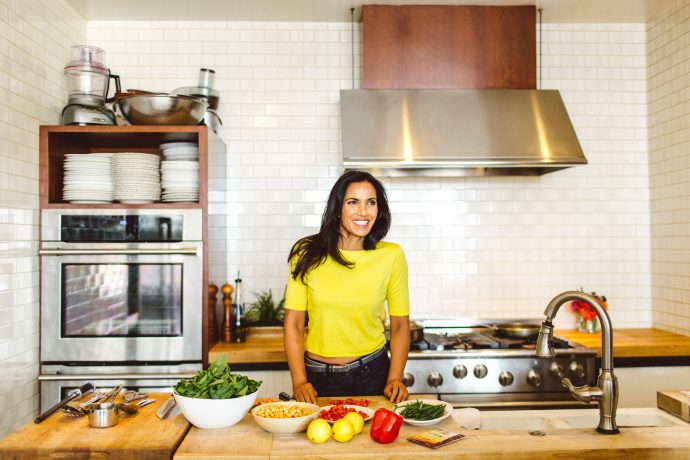
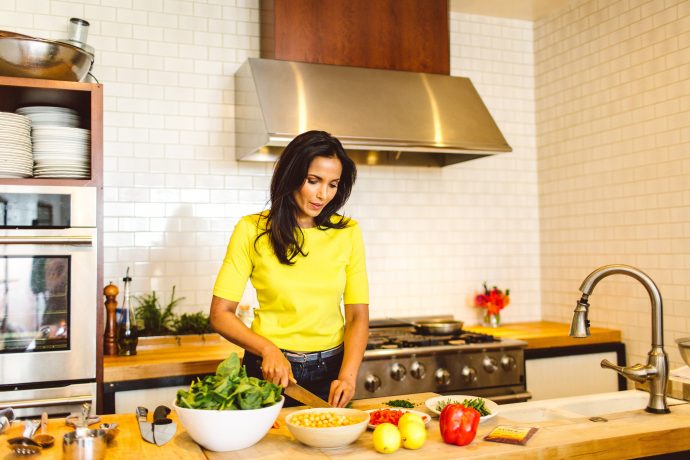
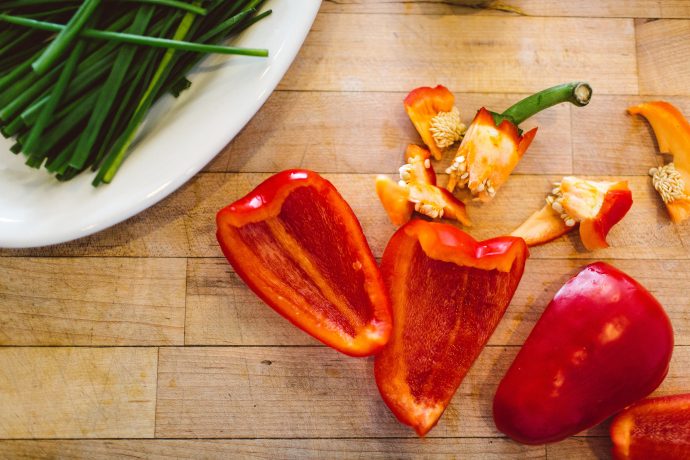
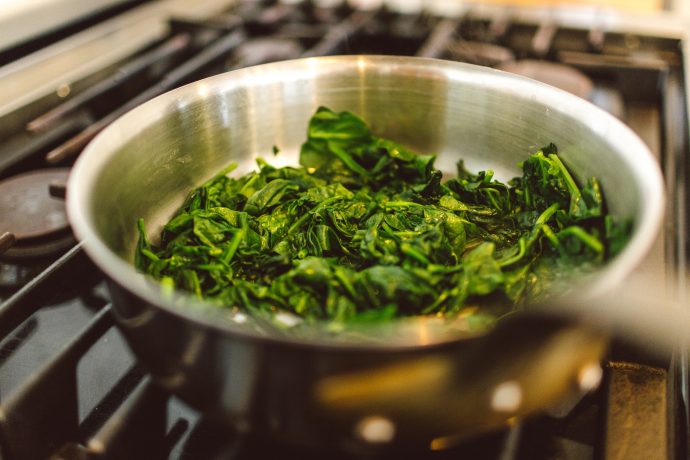
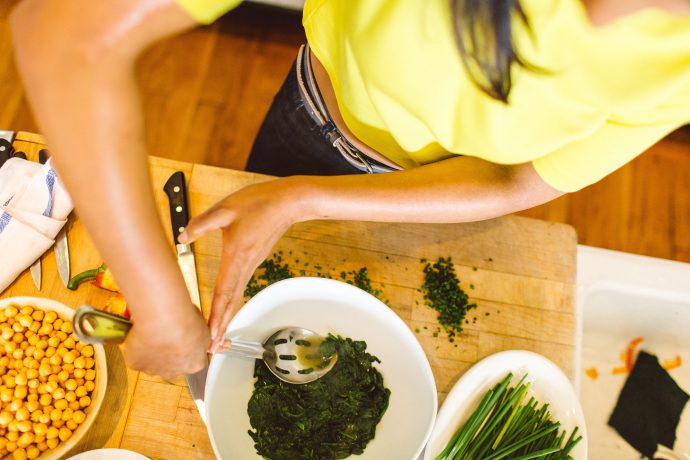
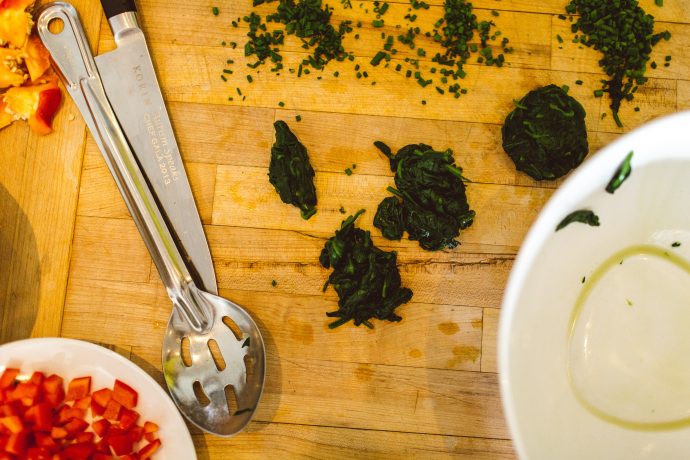
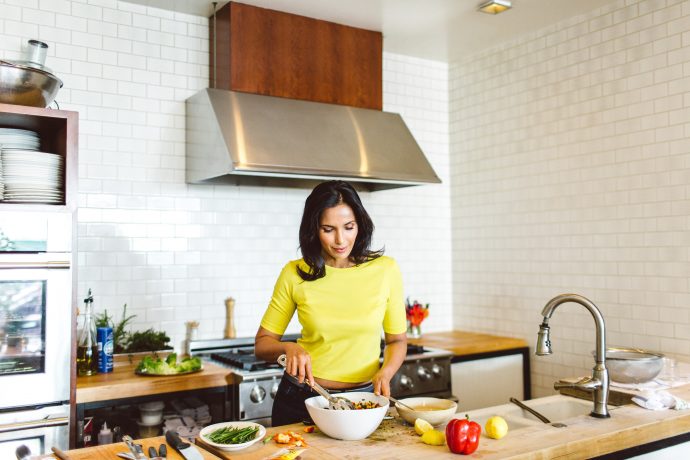
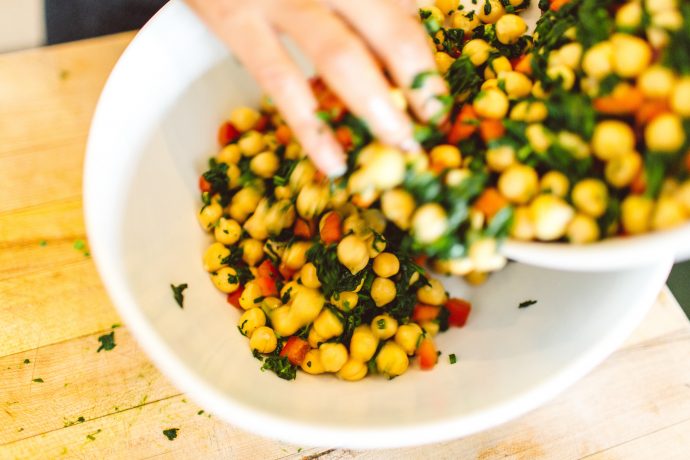
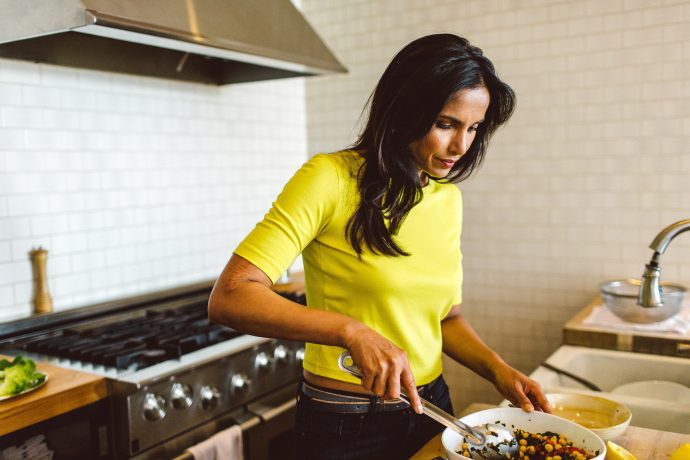
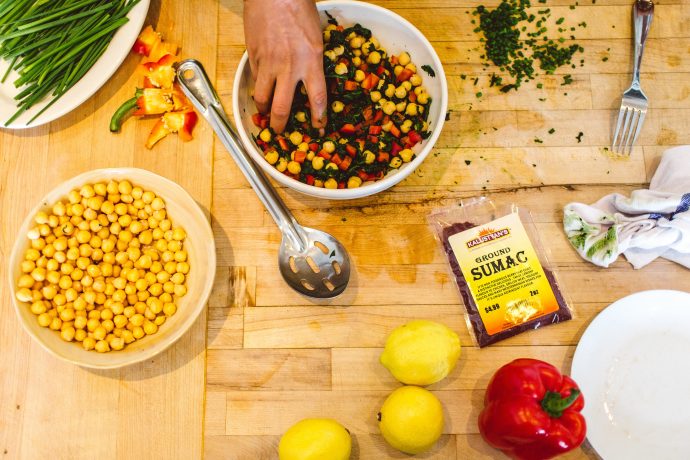
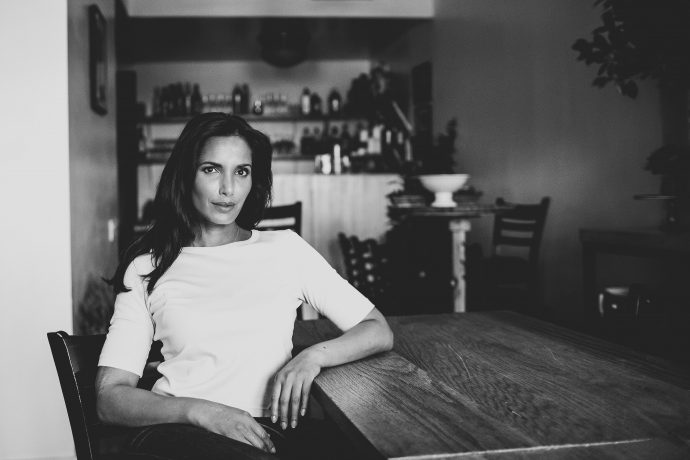
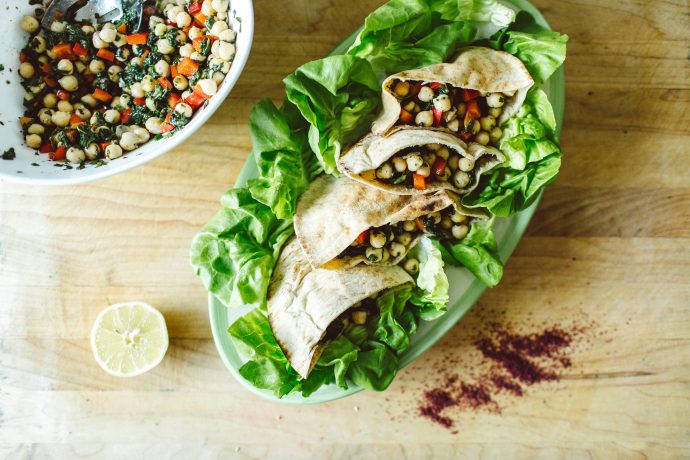



0 Comments